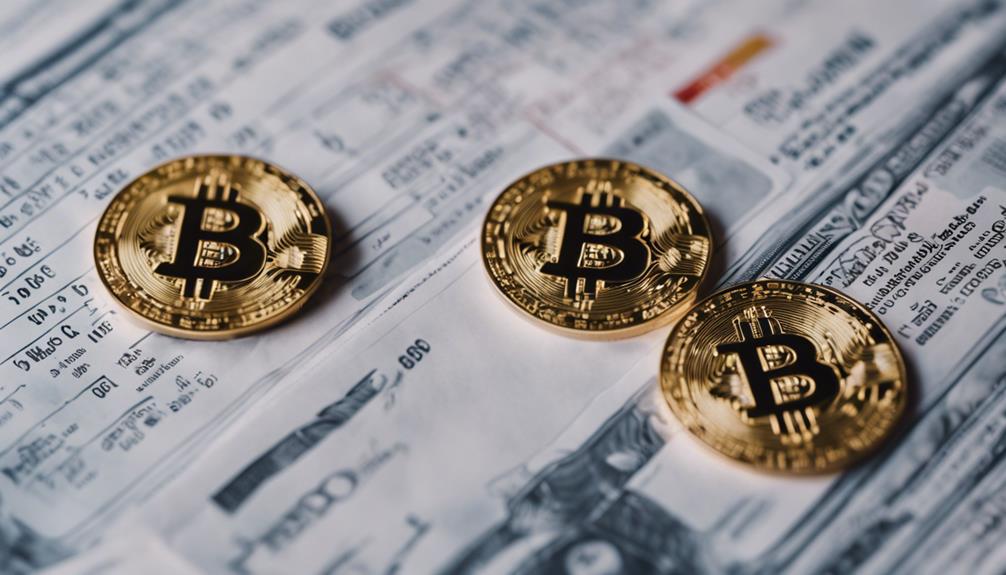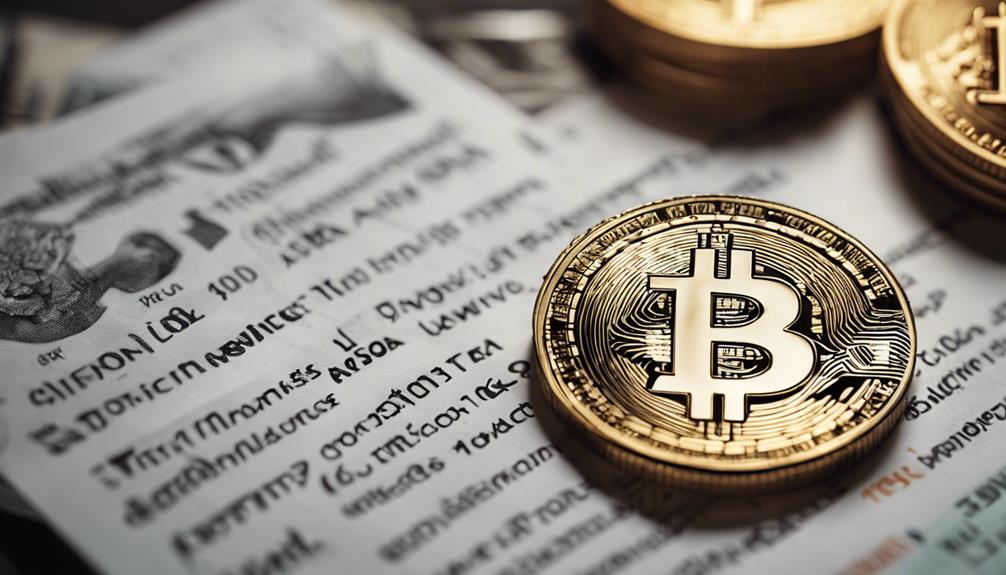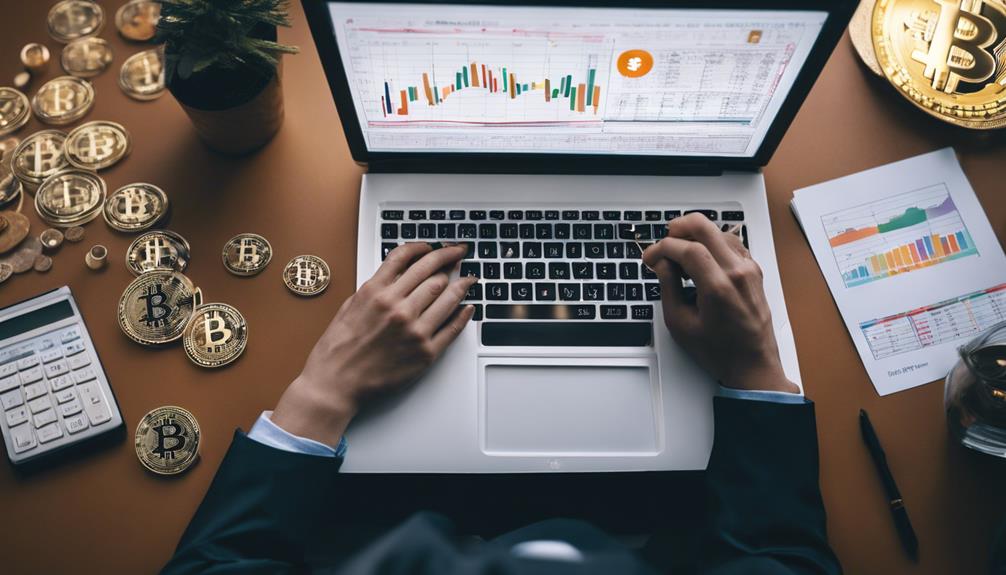Understanding the regulations surrounding Bitcoin IRAs is crucial. Annual contribution limits vary depending on age: those under 50 can contribute $6,000, while those 50 and older can contribute $7,000, with catch-up contributions. The tax treatment differs between Traditional and Roth accounts – taxed distributions versus tax-free withdrawals. Accessing funds early results in a 10% penalty unless certain exceptions apply. Benefits of Bitcoin IRAs include diversification and potential growth, but there are risks like volatility to consider. Tax benefits encompass deductions, growth deferment, and potentially tax-free withdrawals. Cryptocurrency is treated as property under the rules. Compliance is essential in order to maximize retirement savings wisely, aligning with contribution limits and tax guidelines. There is always more to learn about effectively managing Bitcoin IRAs.
Key Takeaways
- Annual contribution limits: $6,000 for under 50, $7,000 for 50 and above.
- Tax treatment: Traditional IRAs taxed on distribution, Roth IRAs offer tax-free withdrawals.
- Early withdrawal penalties: 10% penalty before age 59 1/2, with exceptions.
- Benefits: Diversification, potential growth, and tax advantages.
- Risks: Cryptocurrency volatility, regulatory changes, and market dependency.
Contribution Limits for Bitcoin IRAs

When considering Bitcoin IRAs, it is important to understand the contribution limits set by the IRS to guarantee compliance and avoid potential tax implications. The annual contribution limit for individuals under 50 years old stands at $6,000 for their Bitcoin IRAs, while those aged 50 and above have the opportunity to contribute up to $7,000 annually.
These contribution limits, regulated by the IRS, are essential to grasp as they help individuals avoid tax penalties and ensure adherence to legal guidelines. In addition, contributions to a Bitcoin IRA may be tax-deductible, depending on whether it is a Traditional or Roth IRA.
Age-Based Contribution Caps

Age-based contribution caps in Bitcoin IRAs are structured to allow individuals to increase their retirement savings as they grow older. These limits adjust based on age to accommodate varying financial needs and retirement timelines. For individuals under 50 years old, the contribution limit for a Bitcoin IRA in 2023 stands at $6,500. However, those aged 50 and above have the opportunity to make catch-up contributions of up to $1,000, elevating their contribution limit to $7,500. This age-based approach to contribution limits in Bitcoin IRAs recognizes the importance of saving more as retirement approaches, enabling individuals to bolster their financial security during their later years. Understanding these age-based contribution caps is essential for effectively planning and maximizing retirement savings within a Bitcoin IRA.
| Age Group | Contribution Limit |
|---|---|
| Under 50 | $6,500 |
| 50 and above | $7,500 |
Tax Treatment of Bitcoin IRA Withdrawals

The tax treatment of Bitcoin IRA withdrawals varies depending on the type of IRA selected, either traditional or Roth, impacting the financial implications for retirees. When contemplating Bitcoin IRA withdrawals, it is important to grasp the tax implications, especially in the context of traditional IRA distributions and early withdrawals. Here are some key points to keep in mind:
- Traditional IRA distributions may be subject to income tax, similar to withdrawals from a Bitcoin IRA.
- Roth Bitcoin IRAs offer the advantage of tax-free withdrawals in retirement, potentially reducing tax burdens.
- The type of IRA chosen will determine the tax treatment of withdrawals, influencing your overall tax strategy during retirement.
- Early withdrawals from a Bitcoin IRA could lead to penalties on top of the taxes owed, affecting your retirement savings.
- Properly evaluating the tax consequences of Bitcoin IRA withdrawals is vital for effective retirement planning and maximizing your savings over time.
Penalties for Early Access

Accessing funds from a Bitcoin IRA before reaching the age of 59 1/2 may result in a 10% penalty on the withdrawn amount, which can have a major impact on retirement savings. This penalty applies to both traditional and Roth Bitcoin IRAs, emphasizing the importance of understanding the consequences of early access on your financial future.
Exceptions to the penalty exist for specific circumstances like disability, medical expenses, or first-time home purchases, but it's important to be aware of the implications to make informed decisions regarding your Bitcoin IRA.
Early Withdrawal Penalties
Early access to funds in a Bitcoin IRA before reaching age 59 1/2 can result in a 10% penalty, in addition to potential income tax implications. Understanding the specific rules and penalties for early withdrawal is important.
Here are some key points to keep in mind:
- Traditional Bitcoin IRAs may incur income tax on early withdrawals, along with the 10% penalty.
- Roth Bitcoin IRAs allow penalty-free early withdrawals on contributions but not on earnings.
- Exceptions to early withdrawal penalties include disability, certain medical expenses, or a first-time home purchase.
- Proper planning is essential to avoid unnecessary penalties and taxes.
- Educating oneself on the regulations surrounding early access to Bitcoin IRA funds is crucial for effective retirement planning.
Impact on Retirement Savings
Withdrawal from a Bitcoin IRA before the age of 59 1/2 can have significant financial implications on retirement savings, including a 10% penalty and potential income tax obligations. Early access to these funds may jeopardize long-term financial goals by reducing the overall retirement savings. To illustrate the impact of early withdrawals, consider the table below:
| Financial Impact | Description |
|---|---|
| Tax | Early access may trigger additional taxes |
| Penalty | A 10% penalty is applied before age 59 1/2 |
| Retirement Savings | Reduction in funds allocated for retirement |
Understanding the repercussions of tapping into a Bitcoin IRA prematurely is essential for individuals planning their retirement strategy, emphasizing the importance of adhering to the regulations to secure future financial stability.
Diversifying Retirement Savings With Bitcoin IRAS

Diversifying retirement savings with Bitcoin IRAs offers benefits like exposure to a high-growth asset class, potential portfolio growth, and tax advantages for long-term wealth accumulation.
However, investors need to carefully consider the risks associated with cryptocurrency volatility, regulatory changes, and security concerns when incorporating Bitcoin IRAs into their retirement strategy.
Looking forward, the future growth potential of Bitcoin IRAs hinges on continued adoption, market stability, and evolving regulations within the cryptocurrency space.
Benefits of Bitcoin IRAs
Bitcoin IRAs present a unique opportunity for investors to diversify their retirement savings by incorporating exposure to the cryptocurrency market. By considering a Bitcoin IRA, individuals can benefit from tax-free growth, potentially hedging against traditional market risks.
The following points illustrate the advantages of Bitcoin IRAs:
- Tax-Free Growth: Enjoy the potential for tax-free growth on your investments within a retirement account.
- Diversification Benefits: Hedge against traditional market risks by diversifying your portfolio with Bitcoin in an IRA.
- Cryptocurrency Exposure: Gain exposure to the cryptocurrency market through a tax-advantaged retirement account.
- Long-Term Growth Potential: Investing in Bitcoin via an IRA can provide long-term growth opportunities.
- Balanced Portfolio: Use Bitcoin in an IRA to balance your portfolio with alternative assets, potentially enhancing overall stability.
Risks to Consider
While exploring the potential benefits of incorporating Bitcoin IRAs into retirement savings, it is essential to carefully evaluate the associated risks to make informed investment decisions. Bitcoin IRAs can expose retirement savings to the extreme volatility of the cryptocurrency market, leading to potential high returns but also high risks.
Proper risk management strategies, such as diversifying with traditional investments, are vital when considering Bitcoin IRAs to mitigate the inherent volatility. Balancing the portfolio with a mix of assets can help spread risk and protect against sudden market fluctuations.
Understanding the risks associated with Bitcoin IRAs is pivotal for long-term retirement planning, ensuring that individuals are prepared for the potential ups and downs that come with investing in this emerging asset class.
Future Growth Potential
Exploring the potential for future growth in retirement savings through the incorporation of Bitcoin IRAs presents investors with an opportunity to leverage the dynamics of the cryptocurrency market. Investing in Bitcoin IRAs can offer the following emotional benefits to investors:
- Excitement from participating in a cutting-edge financial technology.
- Hope for significant wealth accumulation through strategic cryptocurrency investments.
- Confidence in diversifying retirement savings beyond traditional assets.
- Anticipation of potential high returns in a rapidly evolving market.
- Security in hedging against economic uncertainties with a non-traditional asset class.
Potential Tax Benefits of Bitcoin IRAs

Are there significant tax advantages associated with investing in a Bitcoin IRA?
Bitcoin IRAs offer potential tax benefits that can enhance retirement savings strategies. One key advantage is the ability to make tax-deductible contributions, which can lower current taxable income. This feature allows investors to save for retirement while potentially reducing their tax burden in the present.
Additionally, earnings within a Bitcoin IRA grow tax-deferred, meaning that individuals can benefit from investment growth without immediate tax implications. When it comes time to make withdrawals, traditional Bitcoin IRAs may be subject to taxes similar to traditional IRA distributions. However, Roth Bitcoin IRAs provide an alternative option by offering the potential for tax-free withdrawals in retirement.
This tax-efficient structure can be advantageous for individuals seeking to access their funds without incurring additional tax liabilities. Understanding these tax benefits of Bitcoin IRAs is essential for making informed decisions about retirement planning and maximizing tax advantages in the long term.
Growth Opportunities in Bitcoin IRAs

Bitcoin IRAs present investors with a unique opportunity to capitalize on the growth potential of the cryptocurrency market while benefiting from potential tax advantages for retirement savings. Investing in Bitcoin IRAs can offer significant growth opportunities due to the following reasons:
- Tax-Deferred Growth: Investments in Bitcoin IRAs can grow tax-deferred, allowing for potential compounding over time, leading to enhanced returns.
- Exposure to Cryptocurrency Market: Bitcoin IRAs provide exposure to the growing cryptocurrency market within a retirement account, enabling investors to diversify their portfolio.
- Enhanced Growth Potential: The tax advantages of Bitcoin IRAs can enhance the growth potential of investments compared to traditional IRAs, maximizing long-term gains.
- Diversification Benefits: Diversifying retirement savings with Bitcoin IRAs can help investors capitalize on the growth potential of digital assets, reducing overall portfolio risk.
- Long-Term Wealth Accumulation: By leveraging growth opportunities in Bitcoin IRAs, investors can work towards building substantial wealth for their retirement years, securing their financial future.
Rules and Regulations for Bitcoin IRAs

Given the unique growth opportunities presented by Bitcoin IRAs, it is essential for investors to understand the rules and regulations governing these accounts. Bitcoin IRAs are subject to IRS regulations treating cryptocurrency as property for tax purposes.
Contributions to Bitcoin IRAs may be tax-deductible, with traditional accounts deferring taxes until withdrawal, while Roth accounts offer tax-free withdrawals. It is vital for investors to grasp the contribution limits, tax treatment, and reporting requirements associated with Bitcoin IRAs to guarantee compliance with the law.
Prohibited transactions within a Bitcoin IRA can result in penalties and potential disqualification of the account. Therefore, investors must exercise caution and adhere to the regulations to safeguard their retirement savings.
Making Informed Investment Decisions

When considering investment options within Bitcoin IRAs, it is important for investors to make informed decisions based on a thorough understanding of the tax implications and benefits associated with each IRA type. To navigate the complexities of Bitcoin IRAs effectively, investors should consider the following:
- Contribution Limits: Understanding the annual contribution limits of $6,000 or $7,000 for individuals aged 50 and above is essential for maximizing investment potential.
- Tax Treatment: Recognizing the tax treatment disparities between Roth and Traditional IRAs can have a substantial impact on long-term financial outcomes.
- Tax Implications: Being aware of the tax implications of contributions and withdrawals in Roth and Traditional IRAs is necessary for strategic retirement planning.
- IRA Type Suitability: Evaluating whether Roth IRAs are suitable for higher tax brackets at retirement or if Traditional IRAs are better for stable or lower tax brackets is fundamental in decision-making.
- Benefits Analysis: Conducting a thorough analysis of the benefits associated with each IRA type is crucial for aligning investment strategies with individual financial goals.
Frequently Asked Questions
What Is the Limit for Bitcoin Ira?
The limit for a Bitcoin IRA is $6,500 for individuals under 50 years old in 2023. Those aged 50 and over have the option for a catch-up contribution of $1,000, raising the limit to $7,500.
Contributions are tied to earned income, ensuring a maximum amount that can be contributed. Spousal IRAs allow non-working spouses to contribute based on the earned income of the working spouse.
The contribution deadline typically extends until the tax-filing date of the following year.
How Are Contributions Made to a Roth IRA Handled for Tax Purposes?
Contributions made to a Roth IRA are handled for tax purposes in a unique manner. These contributions are made with after-tax dollars and are not tax-deductible. Due to this, the funds added to a Roth IRA have already been taxed, meaning that contributions do not provide immediate tax benefits.
However, the advantage lies in the fact that Roth IRA contributions grow tax-free, and withdrawals are generally tax-free in retirement, providing a tax-efficient retirement savings vehicle.
Can You Contribute Bitcoin to an Ira?
While Bitcoin cannot be directly contributed to an IRA due to IRS regulations regarding cash contributions, individuals can purchase Bitcoin with cash and then contribute the cryptocurrency to their IRA.
However, finding a custodian willing to accept cryptocurrency for an IRA can be challenging. It is crucial to follow IRS guidelines and work with a reputable custodian to guarantee compliance and proper handling of Bitcoin contributions within an IRA.
What Are the Tax Implications of Contributing to an Ira?
Contributing to an IRA can have significant tax implications. Traditional IRA contributions are often tax-deductible, reducing taxable income and potentially lowering current tax bills.
On the other hand, Roth IRA contributions are made with after-tax dollars, meaning they are not tax-deductible initially. Understanding these tax implications is essential for maximizing the benefits of retirement savings and planning effectively for future financial goals.
Conclusion
In summary, understanding the regulations surrounding Bitcoin IRAs is vital for making informed investment decisions.
While some may question the volatility of cryptocurrencies, it is essential to contemplate the potential growth opportunities and tax benefits these IRAs can offer.
By diversifying retirement savings and following the rules and regulations set forth, individuals can secure a more stable financial future.










